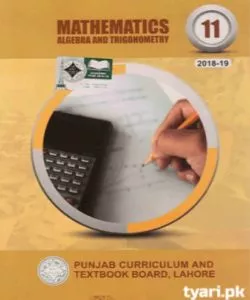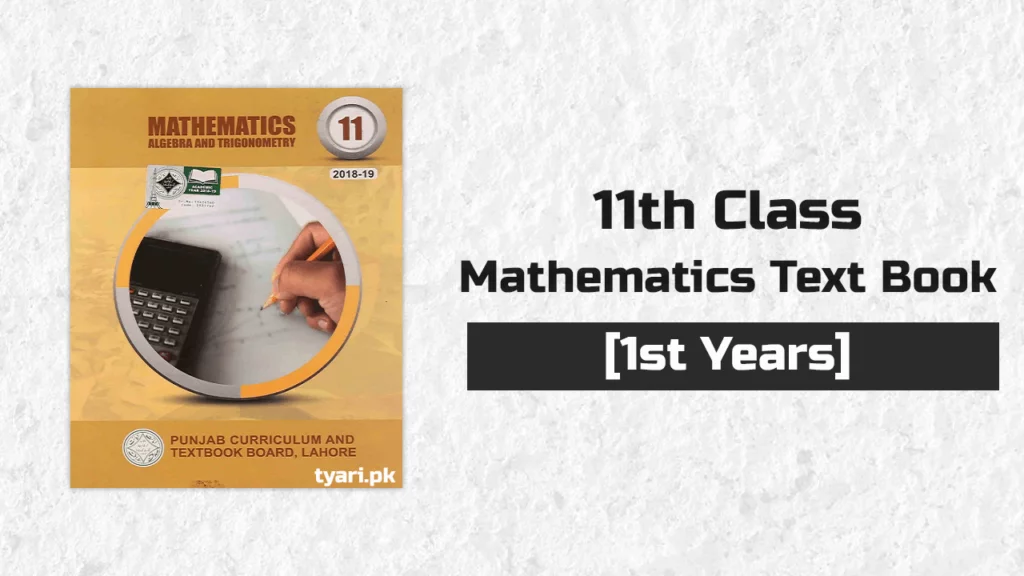11th class Mathematics Text book [1st Years] – PDF & Read Online
Mathematics book for class 11 Punjab board Book pdf Download and You can Also Read Online. This Mathematics textbook is For 1st-year Students of FSC and ICS. This Book Only For those who don’t have access to the hard copy and Personal Use Only.
Download & Online Mathematics Book 11th Class in English Pdf View:

Download Mathematics 11 Class Punjab
PDF Size: 63 MB
11th Class Mathematics Text book:
11th Mathematics Class Book by Punjab textbook board
This 1st edition of the book of mathematics for intermediate Part-1 is co-authored by four professors, Prof. Shamshad Muhammad Lodhi (late), Prof. Muhammad Sharif Ghouri, Prof. Sanaullah Bhatti, and Prof. Khalid Saleem. The book is edited and supervised by Mazhar Hayat. This book is published by Nadeem Lawbook house and is printed by G.F printing press, Lahore, in April 2018.

What is inside the book?
The book has two portions. The first portion about algebra starts from chapter 1. It ends in chapter 8, including the concepts of number systems, sets, matrices, quadratic equations, partial fractions, sequences, series, probability, and binomial theorem, which are the ones with which the students are already familiar to some extent, except the last three. So the major part of this algebra portion is simply a kind of revision of your previous concepts. And the second portion, comprising of the last 6 chapters, is all about trigonometry.
Chapter 1: Number Systems
The chapter begins by answering the question, “Why was there a need to expand the number system, i.e., why was the set of natural numbers not enough?” and takes us from rational and irrational numbers to Real numbers and then to the biggest set of number systems, i.e., the complex numbers. Their properties and graphical representation are elaborated here.
Chapter 2: Sets, Functions, and Groups
In the beginning, the chapter deals with some already familiar concepts of Sets and a new concept of “Logic: Inductive and deductive,” and then it links set theory and logic by truth sets. From this point onward, the chapter goes towards function and its types, which again is a previously studied concept. In this chapter, the new things are Linear and quadratic functions, the inverse of a function, binary operations, their properties, and groups.
Chapter 3: Matrices and Determinants
Until this level, the students were only familiar with finding the determinant, adjoint, and inverse of a 2 by 2 matrix. Still, the chapter introduces the techniques for finding the determinants of greater order matrices, deriving techniques to find the solution of 2 or more homogenous and non-homogenous linear equations through matrices. This is a lengthy chapter and requires lots of practice.
Chapter 4: Quadratic Equation
An exciting chapter about second-degree equations in one and two variables and their solutions by different methods: the chapter also deals with solutions of the equation that are not quadratic but can be reduced to quadratic form by some substitutions. Cube roots and fourth roots of unity with their properties are discussed, followed by synthetic division. In this chapter, we generalize some fascinating results, i.e., relationships between roots of the equation and its coefficients, forming the equation through its given roots, predicting the nature of the root of a quadratic equation discriminant.
Chapter 5: Partial Fractions
This is the simplest chapter of all, which deals with the resolution of rational fractions into partial fractions discussing different cases and techniques.
Chapter 6: Sequences and Series
This is also an extensive but simple chapter with new concepts of series and sequences and related terms such as the arithmetic progression, geometric progression, harmonic progression, and their relationship with each other. In the end, the chapter elaborates the sigma notation, which helps you write series in a compact form.
Chapter 7: Permutation, Combinations, and Probability
The chapter deals with two simple and entirely new concepts of permutation and combination, which come into use when you are interested in finding how many possible ways are there to arrange a group of objects or people or anything. And why would you ever wish to know how many possible ways are there? Well, actually, it is when you are in a situation where you need to decide or predict the outcomes of some experiment or event. It seems interesting, right? You can be a fortune teller if you know the participating variables well.
Chapter 8: Mathematical Inductions and Binomial Theorem
Having its roots in chapter 6, the chapter moves forward with the summations towards a new mathematical induction concept. The chapter also describes a theorem that helps you expand an algebraic expression of two terms raised to any power, deducing some general results and, in the end, giving some applications of the theorem.
Chapter 9: Fundamentals of Trigonometry
A fundamental chapter with all the basic trigonometry concepts discussed, including the important terms and standards to follow while dealing with trigonometry.
Chapter 10: Trigonometric Identities Sum and Difference of Angles
The chapter presents the “Fundamental law of trigonometry” and trigonometric identities of half, double and triple angles. This chapter’s important explanation relates the sum, difference, and product of sines and coines to simplify the problems.
Chapter 11: Trigonometric Functions and their Graphs
A tiny chapter elaborates trigonometric functions through their graphical representation, discussing their domains and ranges with a fundamental periodicity concept.
Chapter 12: Application of Trigonometry
Hard work awaits you here with a lot of derivations and results to memorize. Heretofore you will have covered all the basics of trigonometry. Thus, in this chapter, you will be able to manipulate the trigonometric equations very well, so this chapter is a step forward, leading to trigonometry finding its applications. That is in the geometry of triangular systems alone and triangular systems in connection with circles.
Chapter 13: Inverse Trigonometric Functions
Chapter deals with inverse trigonometric functions that help find the angles for which the values of trigonometric functions are given. The chapter discusses the inverse trigonometric functions and their ranges, domains, curves, and addition and subtraction formulae, along with their proofs.
Chapter 14: Solutions of Trigonometric Equations
This is a very brief chapter dealing with the solutions of trigonometric equations. And the clearer your concepts of previous chapters are, the easier this chapter becomes.
How to study it with PDF effectively?
Studying the math book through PDF is not a big deal. All you have to do is consider it as an E-book. You must have read an E-book or document online. The only issues that may annoy you while reading through PDF can be solved by following simple tips.
- Keep your focus intact, turn off the internet when you are solving a math equation.
- Cover your eyes with good quality glasses to keep the eyesight intact.
- Take breaks after every 30 minutes for a safe read.
- Keep a pen and notebook to take notes.
Conclusion
The book is simple yet demands a lot of hard work and practice. The focus should be on the concepts because this book is comparatively more theoretical, containing a lot of definitions and derivations. As there is a lot of information in the book on various concepts, any of which are new, it is suggested that you revise the book at least 3 to 4 times before going to the exam.
